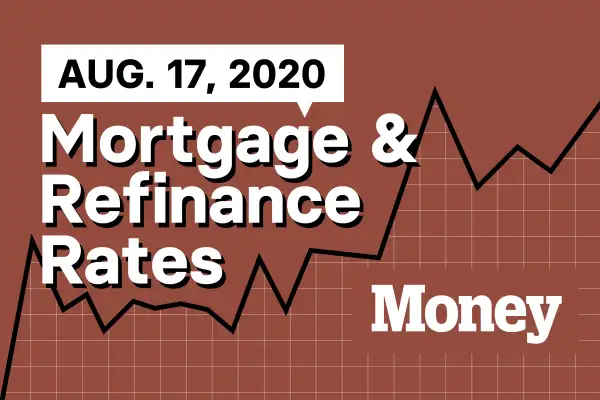Here Are Today's Best Mortgage & Refinance Rates for August 17, 2020

Borrowers with 700 credit scores were charged an average of 3.654% to secure a 30-year fixed-rate purchase mortgage on Friday, according to Money's survey of over 8,000 mortgage lenders across the country. The average rate for a 30-year refinance was 4.509%.
| 30-year fixed-rate mortgage purchase |
| 3.654% |
| Rates of August 14, 2020 |
Refinance Rates Today
A homeowner with excellent credit who qualifies for the lowest rates as reported by Freddie Mac can save a significant amount of money when refinancing. A year ago the average mortgage rate was 3.60%. A homeowner with a $250,000 mortgage balance paying 3.60% on a 30-year loan could cut their monthly payment from $1,137 to $1,049 by financing at today’s lower rates. (It is important to consider closing fees and that refinancing could reset the clock on your mortgage, meaning you will have to make payments longer.)
For more on refinancing read: Is Now a Good Time to Refinance My Mortgage? A Decision-Making Guide
What else do house hunters need to know today?
The number of building permits issued for single-family homes increased during the first six months of 2020 compared to a year earlier, providing a much-needed boost to a housing market running low on inventory. Meanwhile, builder confidence jumped to its highest rating in 35 years.
According to the National Association of Home Builders, the number of building permits issued year-to-date for single-family homes increased 3.8% year-over-year, despite the disruption caused by the COVID-19 pandemic. So far there have been 433,484 permits issued compared to 417,453 by the same point in 2019.
Of the four regions NAHB measures, the South has seen the largest permit growth so far this year at 6.5%, followed by the Midwest with an increase of 1.8%. The number of permits issued in the West was flat, while the Northeast saw permits decline by 1.7% as of the end of June.
Permits for multi-family properties, however, decreased in the three of the four regions, with the Northeast experiencing the largest drop—14.7% below last year's numbers. The Northeast was followed by the Midwest West and the West, down 6.2% and 5.6% respectively. The South was the only region experiencing apartment growth, up 3.1%.
According to the NAHB/Wells Fargo Housing Market Index, builder confidence in new single-family homes rose 6 points to a reading of 78 in early August, matching the record high in the 35-year history of the series set in December 1998.
"Housing has clearly been a bright spot during the pandemic and the sharp rebound in builder confidence over the summer has led NAHB to upgrade its forecast for single-family starts, which are now projected to show only a slight decline for 2020," said Robert Dietz, chief economist for the NAHB. "Single-family construction is benefitting from low interest rates and a noticeable suburban shift in housing demand to suburbs, exurbs and rural markets as renters and buyers seek out more affordable, lower density markets."
What should house hunters be watching this week?
On Tuesday, The U.S. Census Bureau will release data on housing starts during the month of July. It's estimated that new home construction will increase by 3.7%, following a June surge of 17.3%. The Mortgage Bankers Association will also release its weekly survey of the number of home loans still in forbearance plans Tuesday, which has been steadily on the decline.
Mortgage Term of the Week
Understanding the lingo can be key to avoiding mistakes when you are buying a home or refinancing your mortgage.
APR or Annual Percentage Rate: The interest rate you will pay on the loan amount plus origination costs and any other fees. It will be higher than the advertised rate. The APR will give you a more precise understanding of your monthly payment. Consumer lenders are required to show borrowers the APR on their loans and all must use the same formula to calculate the rate.
For more: Everything You Need to Know About Mortgage Rates in 2020
Bottom Line:
Fall Homebuying Outlook: Everything You Need to Know About Prices, Supply and Mortgage Rates
